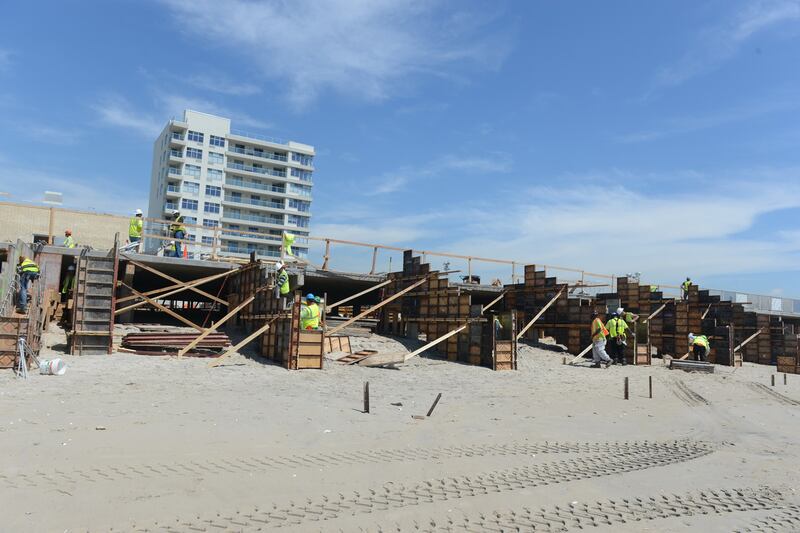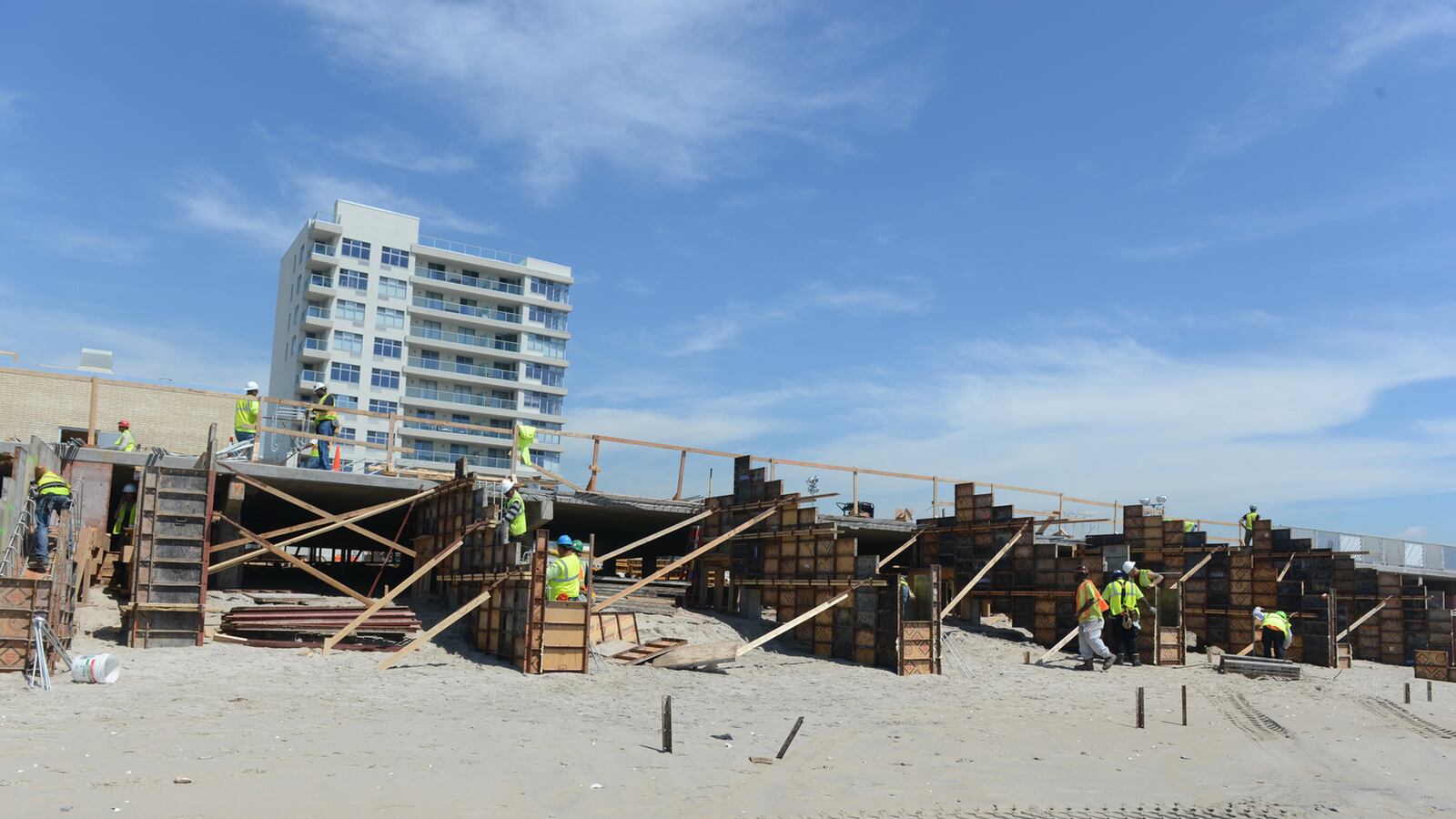In Far Rockaway, Queens, the beloved Rockaway Taco is open again, peddling $3 fish tacos and fresh watermelon juice. Some 75 miles south, in Belmar, New Jersey, a new 1.3 mile boardwalk sports a fresh coat of “spiced rum” colored paint, courtesy of Captain Morgan. And in Seaside Heights, New Jersey, the rickety Jet Star rollercoaster, dramatically submerged in the ocean after Superstorm Sandy, has been demolished to make room for swimming and surfing.

It’s the official kickoff of summer, and up and down the East Coast, tourism-dependent towns devastated by Sandy are declaring themselves back in business. But while a great deal of money and time has been spent to make the beaches appear normal again, from enormous new lifeguard towers tugged in by barges to food carts set up where storefronts remain shuttered—some things will be noticeably different. In Rockaway, for example, only the concrete supports remain from its once-busy boardwalk. Elsewhere—and you might not notice this at first—the sand itself could look a little off.
That’s because Sandy washed away not just homes and boardwalks, but entire beaches. Dunes were leveled and millions of tons of sand were plowed inland. The shore from Bay Head to Sandy Hook eroded more than 100 feet and lost about seven feet of elevation.
In parts of New York, the storm caused 30 years' worth of erosion in a single blow. The work there began immediately, with volunteers shoveling sand out of their basements and yards. Then came the Army Corps of Engineers, which went through streets with front-end loaders, scooping up heaps of sand and depositing them on giant mechanical screens to be sifted for debris. The sifter dumped flotsam—bricks, wiring, barbecue grills, bicycle wheels—in piles to be shipped to landfills upstate. The newly cleaned sand was piled into neat cones, ready to be trucked back to the beach, where it was dumped between the gap-toothed stanchions that are used to hold boardwalks. In the six weeks after the storm, Corps crews and private contractors sifted and replaced 185,000 cubic yards of sand from New York’s beaches, enough to fill a football field to a depth of almost 60 feet.
The sand looks almost pristine now that the cinder blocks and metal pipes have been removed, but the sifters aren’t perfect, and small fragments of debris remain. Once the sand was plowed back onto the beaches, volunteers scoured it for any flotsam that got through the sifting machines. Jason Maas, one of those volunteers, was an artist living in Red Hook, Brooklyn, when his studio was flooded with seven feet of water. Soon after, he became a full-time volunteer in the Rockaways with Respond and Rebuild, scrubbing mold off beachfront homes and picking through sand for debris, including household trash, rusty nails, and wooden planks.
He says he’s optimistic about summer in the Rockaways.
“More New Yorkers have developed a connection to Rockaway since Sandy,” Maas says. “Even homeowners here who have been wary of outsiders intruding on their space are thankful for their presence and business now. People are going to find the beach shorter, with less sand, but it’s still here and still beautiful.”
Nearby, Fort Tilden Beach is one of the few local beaches that will not reopen this summer. Manjari Doxey and a volunteer team called Clean Up Fort Tilden found the beach practically untouched and in ruins six months after Sandy hit. “It looks like crap,” Doxey says, “I’ve never seen a beach that looks like this. There’s just rows of exposed wood everywhere.” She says she got involved volunteering not only to clean up the beach but to help fortify it. Her big fear: “What would happen if another major storm hits?”
It’s a fear that’s being echoed up and down the coast, even as people are grateful to have their livelihoods restored and their hotels slowly booking up. Another big storm season is headed this way, with a predicted 13 to 20 named storms. Securing against such weather—not just this year, but for the indefinite future—requires more than new boardwalks and taco stands.
It requires sand—lots and lots of sand, says Chris Gardner, a spokesman for the Corps’ New York branch. “You see a beach, your first thought is it’s beautiful, but year round it’s providing risk reduction for the community,” he says. It’s the dunes that “prevented hundreds of millions of dollars more damage during Irene, during countless nor’easters, and mitigated impact during Sandy.”

Sifting sand and putting it back in place is really a short-term fix, say experts. It provides enough beach area to satisfy sunbathers, but not to protect against more hurricanes. For that, engineers are embarking on a hugely ambitious plan: moving 40 million tons of sand off the bottom of the ocean floor and plopping it onto the beaches of New York, New Jersey, Delaware, and Maryland.
First things first, says S. Jeffress Williams, a coastal scientist with the U.S. Geological Survey and the University of Hawaii, who conducts surveys of offshore sand. He says you can’t take just any sand. If the grains are too small, they’ll wash away. Too big, and chunks will shear off during a beach’s natural erosion process. That would create a steep cliff rather than a gradually sloping beach—not a huge tourist draw. Once you know you’ve got the right sand, a dredging company can go in, dig up the sea floor, and pump it back to the beach.
Gardner says much of the sand will come from places that are being dredged anyway to keep inlets clear for ship traffic. Rockaway’s sand will come from Rockaway inlet—it’s basically the same sand, he says. They’ll get sand for Gilgo Beach in Long Island when they clear out Fire Island’s inlet. Anything extra will have to come from somewhere offshore.
Back in Far Rockaway, some locals are frustrated with what they say is a lopsided set of rebuilding priorities. “Seven months after Sandy, our beaches still don’t have protection from possible future hurricanes, and the hurricane season for Summer 2013 has officially begun,” read one comment on the Friends of Rockaway Facebook page.
For others, there’s no time like the present to celebrate summer. This weekend marks the fifth annual Memorial Day Bash at the Bungalow Bar and Restaurant in Far Rockaway, one of the lucky restaurants able to open after Sandy. “We’ll always be here,” a flyer promised, “nothing could keep us from opening our doors this summer.”







